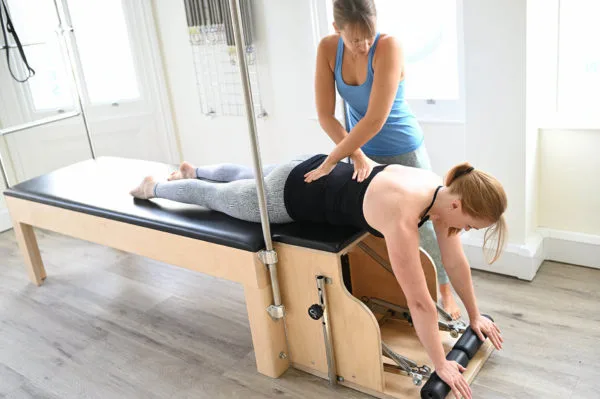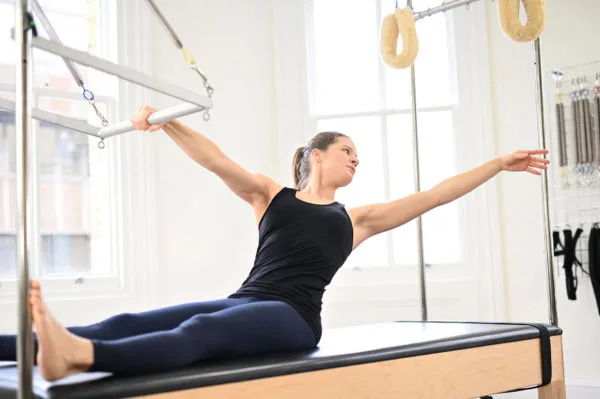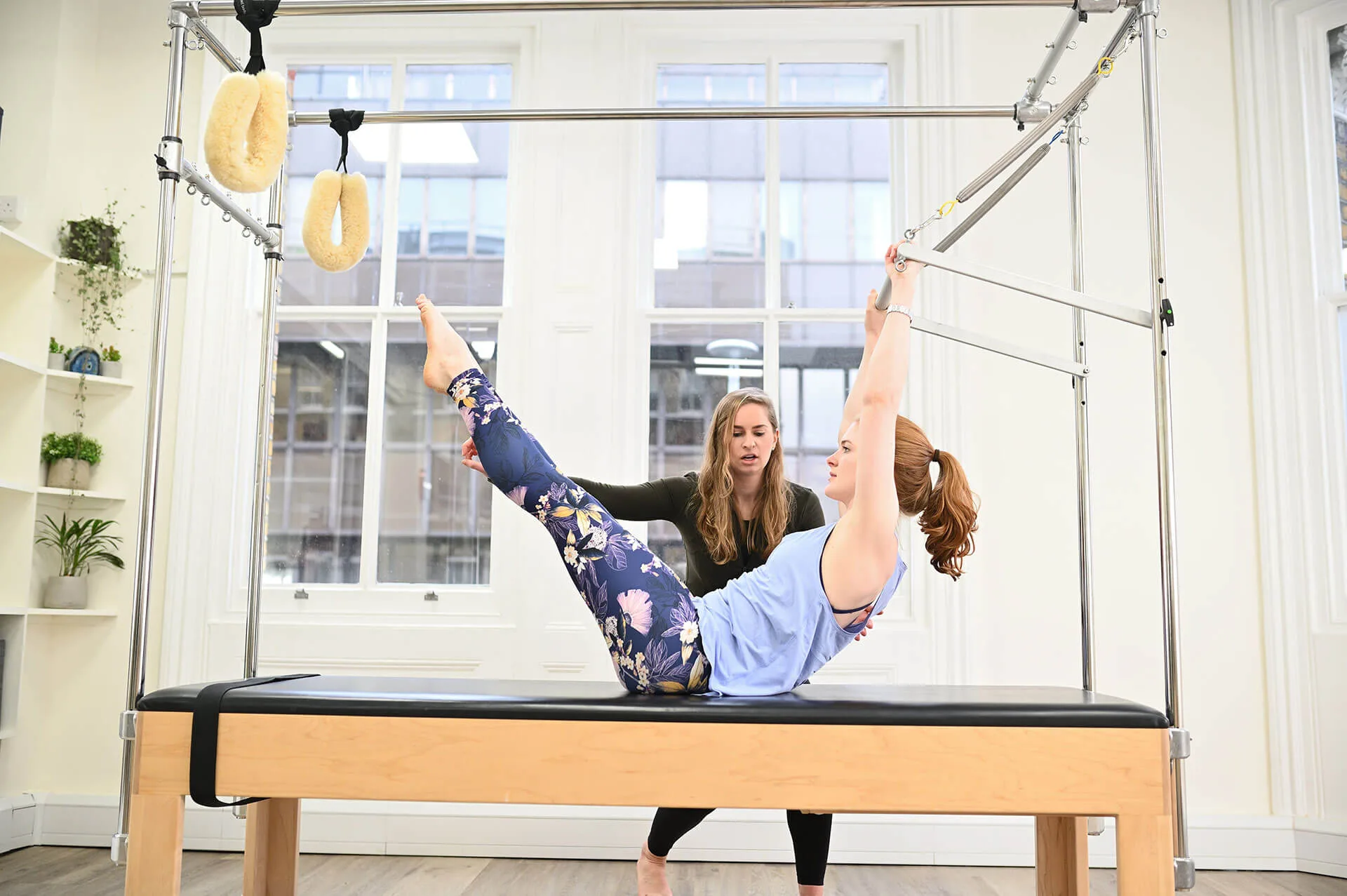Key Contributor: Ami Odendaal, Chartered Physiotherapist
Are you wondering what sciatica is? Or whether the pain you’re currently experiencing is sciatica?
In this article we discuss what sciatica is, the common causes and Pilates exercises for sciatica pain so you reduce and prevent recurrent sciatica symptoms.
What is Sciatica?
Sciatica refers to pain that is localised along your sciatic nerve. Rather than being a diagnosis it is a description of the symptoms.
What is sciatica pain like? Sciatic pain comes in various forms and degrees but usually feels like a constant burning or shooting sensation down the back of the leg.
The sciatic nerve is one of the largest and longest nerves in the body which runs from your lower back through your hips, glutes and extends down each leg behind the knee and splits, going inside and outside of the calf along the top and bottom of the foot.
Sciatic pain can be excruciating and even debilitating at times, which can have a massive impact on the quality of your life and your day to day activities.
That’s why we recognise the importance of understanding the common causes of sciatica, as well as knowing the exercises which can help to reduce or lessen your symptoms of sciatica pain. Importantly we have to understand that sciatica can be caused by a number of different things and getting a clear diagnosis on the cause of your sciatica pain can help to direct treatment more effectively.
Whilst not always possible or comfortable, sciatica can be improved with movement. It is recommended that sciatica sufferers try Pilates, which was originally a practice developed for rehabilitation purposes. The key to movement with sciatica is to be gentle and progress slowly so that you do not to overstretch the nerve which will cause greater irritation.

Pilates teaches us to work in a neutral spine, this is when the 3 natural curves of your spine – your cervical (neck), thoracic (middle) and lumbar (lower) curves – are in good alignment. This position helps to correct imbalances where additional pressure may be added to your sciatic nerve roots causing or contributing to your pain.
Read on to find out what causes sciatica pain and exercises you can do from home to help your sciatica pain. Alternatively, learn how Physio-led Pilates can help.
What causes sciatica?
If you’re currently experiencing sciatica pain but do not know what may be causing the symptoms, there are a few common causes to be aware of. Generally speaking, anything that puts pressure on the sciatic nerve can cause sciatic nerve pain.
- Ruptured or herniated disc: Your spinal disc can become ruptured or herniated when the discs protrude outward causing the disc to press on the nearby spinal nerves. Even when there is no direct pressure on the nerve, surrounding inflammation can cause sciatic irritation and symptoms.
- Spinal stenosis: Spinal stenosis is the narrowing of spaces within your spine which can cause additional pressure on the nerves that travel through the spine, typically in the lower back and the neck. Symptoms can include pain, tingling, numbness and muscle weakness.
- Bone spur on the spine: Bone spurs are small bone projections that form along bone edges, typically where the bones meet each other. These can also cause pressure on the nerve.
- Injury: can cause trauma to the nerve which results in swelling and thus triggering sciatica.
- Muscle spasm: As the nerve travels through muscles on its way down the leg any changes such as muscle spasm, injury or swelling can also irritate the nerve and cause sciatica.
- Facet joint inflammation: The joints between each vertebrae in the spine can get inflamed and this inflammation can affect the sciatic nerve and give you symptoms of pain.
Pilates Exercises for Sciatica Pain

Gentle movement and exercises can be important in the recovery and prevention of sciatica nerve pain. However, it is important not to worsen the irritation on the nerve by overstretching during exercise or when moving. That’s why Pilates exercises for Sciatica can be very beneficial when done correctly.
If your sciatica is caused by an injury to the disc it is important to allow healing to occur without overloading the area, overstretching the nerve excessively or doing unnecessary end of range flexion and extension of the spine.
We always recommend you seek professional help and support in the first instance to ensure at home exercises for sciatica are suitable and safe for you to do.
As expert and experienced Clinical Pilates Instructors and Physiotherapists, we have put together a guide of exercises for sciatica pain which you can do from the comfort of your own home. You can try these if you have sciatica pain but remember the best advice is to get an individual assessment so that you can be specifically diagnosed and given advice and exercise that are appropriate for you and your body.
These exercises are safe and effective if you do not push into pain and start gradually.
1. Bridge exercise
A basic bridge exercise, also known as a hip raise or glute bridge, aims to target and strengthen your glutes, abs and hamstrings. When incorporated into a rehabilitation programme, the basic bridge can help to improve core and spinal stabilisation. This will assist in offloading the areas where the sciatic nerve travels reducing any muscle imbalance.
- Start by lying on your back with your hands either side, knees bent with your feet flat on the floor under your knees.
- Remember your pelvic clock – keep your hip bones level, engage your abdominals and glute muscles by pushing your lower back towards the ground.
- Raise your hips upwards creating a straight line along your knees, legs, abdominals and shoulders.
- Hold and then return to your starting position.
- Repeat.
2. Lower and lift
The Pilates lower and lift is a simple exercise for sciatica pain that focuses on pelvic stability by abducting the leg outward at the hip.
- Start by lying on your side with your hips and shoulders in a straight line and your underneath knee bent so that your underneath thigh is at a 90-degree angle to your body.
- Bend your top arm and place your hand gently in front of your chest on the floor for extra stability.
- Reach the top leg long so that you feel your waist lengthen. Keep the length in your waist as you lift the leg from your hip.
- Slowly bring your leg back to hip height.
- Repeat
- Change side, and repeat.
3. Dead bugs and femur arcs
Whilst the ‘dead bug’ sounds like an odd exercise to do, it’s not. The dead bug exercise is hugely beneficial for improving your pelvic stability and differentiating the movement between your hips, pelvis and lower spine. This strength and stability will help to offload the lumbar spine and sciatic nerve through the spine, pelvis and hips.
- Start by lying on your back, knees bent with your feet flat on the floor and your hands rested on your pelvic bone.
- Sigh a breath out and lift one leg up to table top to create a 90 degree bend, hold and then bring your leg back to starting position. Breathing out to lift allows you to automatically engage your stabilising muscles.
- Alternate, and lift the opposite leg.
- Repeat.
This movement can be advanced by progressing to femur arcs.
- Start by lying on your back with your legs in tabletop position.
- Slowly lower one foot to the floor maintaining the 90 degree bend, hold and then bring your leg back to starting position – tabletop.
- Alternate, and lower the opposite leg.
- Repeat.
4. Figure 4 stretch
Figure 4 stretch or modified pigeon stretch helps to relieve muscle tension in the glutes area. This can help to reduce the pressure in the sciatica nerve if muscle tension or spasm is part of the problem. This can also be done in sitting.
- Start by lying on your back with your knees bent.
- Lift one foot onto the opposite knee.
- Pull your thigh in towards your chest until you feel gentle stretch in the glutes.
- Hold for 10-20 seconds and gently rock side to side.
- Repeat both sides.
5. Sciatic mobility
Similarly, this sciatica mobility stretch aims to mobilise the soft tissues down the back of the leg. As we previously said we do not want to overstretch the nerve but gentle movement can help healing and reduction of symptoms.
- Start by lying on your back with your knees bent.
- pull one knee to your chest holding the thigh with your hands.
- Holding the thigh gently towards your chest, extend the knee taking your foot towards the ceiling with the toe pointed. Do this just to the point where you feel comfortable stretch and not pain.
- Bend the knee and flex the toes
- Repeat X6
- and then alternate on the other side.
What do our experts say?
‘’In the acute phase of sciatica, muscles in the painful area contract in response to it. This is a protective mechanism which itself is painful. Gentle movements in Pilates can help to alleviate muscle spasm, thereby reducing overall pain. Since sciatica can recur throughout life, it is worth looking into possible underlying causes. There might be muscle weaknesses or certain movement patterns that contribute to the development of sciatica. By strengthening weak muscles and adopting more efficient movement patterns through Pilates, the frequency of flare-ups can decrease, and recovery can be faster compared to previous episodes.’’
Pilates exercises to avoid with sciatica
Are you wondering which Pilates exercises you should avoid if you have sciatica? Unfortunately, there is no simple answer to this question. It very much depends on the cause of your sciatica and the degree of what physiotherapists refer to as “irritability” level.
For highly irritable sciatica, even the smallest of movements can provoke pain. For low to moderate sciatica, the same exercises can help to relieve pain.
Depending on the cause of the sciatica, some people may find relief from stretches that round the lower back, whereas others may find relief from backwards bending.
If you are in pain with a new condition it is worth noting that the idea of “no pain, no gain” should not apply here. If an exercise increases your pain further, then it is not likely to be helping and you should not push through the pain. New injuries often need relative rest in the first instance, appropriate pain control and some advice from a healthcare professional.
For this reason it is important to see a healthcare professional such as a GP, physiotherapist or a consultant specialising in spinal conditions. An assessment and diagnosis can rule out any serious cause for sciatica and make sure that any treatment programme and exercises can be tailored to you.
How to exercise safely with sciatica?
To ensure you are doing exercises for sciatica pain safely there are a few things to be aware of and consider.
- Start with easy, low impact movements.
- Pay attention to your form and the rhythm of your breathing.
- Stimulate your soft tissues with heat if necessary. This will help to improve blood flow and oxygen, as well as decrease stiffness in the muscles around your spine.
- Avoid exercises such as bent-over row and double leg lift which can either aggravate your sciatic pain or can easily be done with poor form.
- Consider how it feels not only at the time of doing the exercise but also afterwards as nerve irritation can have a delayed onset. We want to avoid aggravating symptoms with the exercises.
As previously mentioned, you should always do exercises for sciatica pain with caution. We recommend seeking advice from a professional prior to exercising. This will allow you to get the perfect advice and exercises for you and your body.
Frequently asked questions
-
Is Reformer Pilates good for sciatica
Reformer Pilates can be particularly beneficial for sciatica because you can use the machinery to assist movements that might otherwise be challenging and painful. As your sciatica improves, the Reformer exercises can be gradually progressed to meet your level.
However, it is important that if you are suffering from sciatica you work with someone who has experience working with injuries. A physiotherapist who is also an instructor or an instructor with experience in clinical Pilates is ideal.
With a painful condition or injury, it is important that you receive appropriate guidance. For this reason, we would not recommend that you undertake reformer Pilates in a fitness or group setting as these are not designed for people with injuries. See a physiotherapist first, and then undertake one-to-one sessions, until it is appropriate to progress to another setting.
-
Is wall pilates good for sciatica?
Wall Pilates, is a modern take on Pilates, made famous by the likes of TikTok and Instagram. Its main benefits are that you can do it anywhere, and it adds some variety to your routine.
If you choose to try out wall Pilates and find that it is helpful for you then by all means continue. However, as with any other type of Pilates, the most important thing is that you can identify which exercises help and which you might want to avoid, and this will differ from person to person – there is no one size fits all approach.
Rather than finding out by trial and error, you can save yourself the guesswork by seeing a health professional who can assess you properly and recommend the right approach for your individual case.
-
What is better for sciatica yoga or Pilates?
If you have read the rest of this article, you may be able to guess what we’re going to say about this one! Yoga and Pilates can both be beneficial for sciatica. However, if you have painful sciatica, you should see a health professional, such as a doctor, physiotherapist or osteopath before beginning any exercise routine.
You may need to undergo a period of treatment, or even medical investigations before commencing exercise. A period of treatment can include exercises to help relieve pain, and exercises that can act as preparation for more challenging Pilates or yoga classes. A gradually progressive exercise programme can return you safely to exercise.
In addition, it would be advisable to find out whether your Pilates or yoga instructor has any additional training in injury rehabilitation. If not, then they should liaise with your chosen health care professional regarding the suitability of any exercise programme.
Here at Complete Pilates we have the best of all worlds. Our company was set up by a physiotherapist and many of our instructors are qualified physiotherapists. In addition our clinical Pilates instructors receive regular training and supervision in managing clients with healthcare conditions and injuries.
We share our premises with Complete Physio, so if we think that you need more thorough assessment and hands on treatment, we can refer you straight across to a team of physiotherapists operating out of clinical rooms.
We also have a network of consultant doctors that we can refer to, to save you time searching for the right specialist to meet your needs.
Join us at Complete Pilates
If you need help with sciatica pain, please book an appointment at one of our Pilates studios in London. You can find us at our Pilates studio in North London or any of our studios (see our Kensington Pilates studio or our London City Studio for more information, please get in touch online or contact us at 0203 764 5668.
For more information, please get in touch online or contact us on 0203 764 5668.
These blogs are designed to give information to everyone, however, it is important to remember that everyone is different! If you have not seen one of our therapists and have any questions about injuries, what you have read or whether this may be useful to you, please just ask. We are more than happy to help anyone and point you in the right direction. Our biggest belief is that education is key. The more you understand about your injury, illness and movement, the more you are likely to improve.





